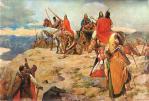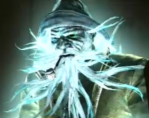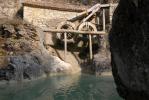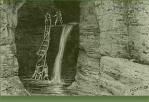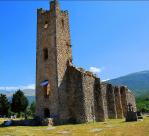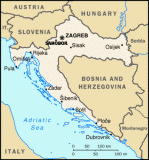Mirila - the measure of a soul
Mirila, stone monuments to the departed, can be found along the mountain paths, passes, elevations and clearings of Mt. Velebit. Mirila date from the times of the Velebit hamlets (17th–20th centuries), that mainly survived from animal husbandry.
They preserve the memories of persons who died on the mountain slopes and had to be carried to the village church and then to the cemetery where they were buried. On such arduous journeys, it was only permitted to stop, rest and place the deceased on the ground in one place - the place where the deceased would greet the sun for the last time.
On this place was erected a mirilo, the resting place of the deceased. Flat stone tablets were generally laid at the head and foot of the deceased, marking his height, to be connected at a later date by a row of stone tablets. The headstones were also sometimes subsequently adorned with symbols carved in shallow relief. These mirila were venerated and visited more than graves, as it was believed that the grave only contained “the body without the soul, which remained at the mirilo.”
Mystical artistic markings on the headstones, among which the cross and solar circle were the most common, bear witness to a continuity of artistic adornment from prehistoric cultures, via early Christianity and the iconography of the stećak (medieval Bosnian standing tombstone), while inscriptions are rare and belong to more recent times. As the stone markers of a unique funeral cult, mirila convey the customs, way of life and creativity of an entire era.
photo: http://www.rivijera-paklenica.hr/en/mirila
http://commons.wikimedia.org/…/File:Velebit_Mirila_Ljubotic…
The beginning of history of many nations got lost in the dark. Few nations know of its beginning and meaning of ther name. Neither we Croats do not know what it means and how it became the name of a Croat. It first appeared as early as the 2nd and 3rd centuries. Azov, at the mouth of the Don, the two Greek inscriptions as a personal name Horoathos and Horouathosa, which is thought to be of Iranian origin. In addition, the Croatian name was used by the two 11th century's Slavic tribes, the Croats in Poland, Great or White Croatia and in the northeastern Czech Republic. Scientists have variously attempted to explain the origins and meaning Croat name, but that did not work either. They agree only in the fact that it is not of Slavic origin. Equally they did not manage to explain the origin of the Croats. They also know only that the Croats in the time of their migration to the south in the 7th century were already part of slavic tribes. They spoke Slavic language and lived by slavic customs.
Ancient homeland Croats was the White Croatia. It lasted until the end of the 9th century and belonged to Great Moravic, then the Kiev, Czech Republic and Poland state. Then it disappears and the name Croat as a name for the local population. Before the oncomming Avars, Croats took refuge among the neighboring Slavic tribes from their ancestral home in the 6th century and migrated further south. They moved into what is today Croatia and with that migration starts the so called big migration of Croatian people.
Ancient homeland Croats was the White Croatia. It lasted until the end of the 9th century and belonged to Great Moravic, then the Kiev, Czech Republic and Poland state. Then it disappears and the name Croat as a name for the local population. Before the oncomming Avars, Croats took refuge among the neighboring Slavic tribes from their ancestral home in the 6th century and migrated further south. They moved into what is today Croatia and with that migration starts the so called big migration of Croatian people.
Casanova in Vrsar – Casanova’s Memories of Vrsar
Keywords: Casanova, memoirs
Region: Istra
Nearest town: Pula
Content: Interesting fact
Casanova in Vrsar – Casanova’s Memories of Vrsar
One of Vrsar’s storied features is its link with Giacomo Casanova, who visited the town on two occasions. Both his stays, the first in 1743, the second in 1744, were more by accident then by intention, but were still documented in his Memoirs.
The first time, according to his own words, he visited Vrsar for three days in August 1743 as a poor and miserable priest. The second time, however, he arrived to Vrsar as a soldier after sailing during the night from the Venetian islet of Malamocco and coming to anchor in the harbour of Vrsar to take ballast. His ship carried 24 guns and two hundred Slavonian soldiers.
Casanova describes Vrsar as a wretched place that he visited for the first time as a miserable-looking priest, while the second time he was unrecognizable – in a splendid uniform, believing he could not be recognized. In mid 18th century Vrsar had an obsolete and extremely rigid feudal system and the County of Vrsar was not able to blend with the modern age trends, especially not with the dynamic and playful Casanova’s spirit.
In his Memoires Casanova details his second stay in Vrsar, where he met a man who had been practising surgery in this place for 20 years, and in a very poor way, for he had had nothing to do. The surgeon invited him for breakfast mentioning his delicious refosco.
At that time wine production was the main branch of economy in Vrsar, and Casanova fancied that the man wanted to make him purchase some refosco.
The episode mentions also Casanova’s adventure with a Vrsar girl, Don Jerome’s housekeeper. Following a series of fortunate events, the surgeon suddenly became very popular and very rich…
http://infovrsar.com/vrsar/experiences-and-attractions/casanova/?lang=en
Mirila - the measure of a soul
Keywords: mystic, mountain, grave stones, soul, heaven
Region: Northern Dalmatia
Content: Cultural and historical heritage
Mirila
Mirila, stone monuments to the departed, can be found along the mountain paths, passes, elevations and clearings of Mt. Velebit. Mirila date from the times of the Velebit hamlets (17th–20th centuries), that mainly survived from animal husbandry.
They preserve the memories of persons who died on the mountain slopes and had to be carried to the village church and then to the cemetery where they were buried. On such arduous journeys, it was only permitted to stop, rest and place the deceased on the ground in one place - the place where the deceased would greet the sun for the last time.
On this place was erected a mirilo, the resting place of the deceased. Flat stone tablets were generally laid at the head and foot of the deceased, marking his height, to be connected at a later date by a row of stone tablets. The headstones were also sometimes subsequently adorned with symbols carved in shallow relief. These mirila were venerated and visited more than graves, as it was believed that the grave only contained “the body without the soul, which remained at the mirilo.”
Mystical artistic markings on the headstones, among which the cross and solar circle were the most common, bear witness to a continuity of artistic adornment from prehistoric cultures, via early Christianity and the iconography of the stećak (medieval Bosnian standing tombstone), while inscriptions are rare and belong to more recent times. As the stone markers of a unique funeral cult, mirila convey the customs, way of life and creativity of an entire era.
photo: http://www.rivijera-paklenica.hr/en/mirila
http://commons.wikimedia.org/…/File:Velebit_Mirila_Ljubotic…
Doomed fisherman
Content: Legend
Doomed fisherman
So called Senj doors are known as uncomfortable area for fishermen and sailors, especially during strong nothern bora wind and south wind called jugo.
Each time stronge storm hits this area, a ghost of doomed fishermen can be seen vigorously paddling toward shore with torn sails and nets in the boat, but never manages to sail into safe harbor.
His curse is deserved by engaging a girl he left soon afterwards, and she threw his ring into the sea, saying , " Let the sea swallowe you " . He did not fulfill a vow of local sailors and fishermen who gave part of their annual earnings for maintaining the old church of St. Nicholas, which was built in the 13th century at bay Marne in Senj, on the site of the strongest storms. Because of his behavior he got a punishment from God and sank in stormy sea during one of his fishing trips. To this date he did not succed to sail in safety of harbor...
The old village of Kotle
Content: Historical site
The old village of Kotle (Istra) - is on the right side of "Glagolitic alley" which you climb to the smallest town in the world - Hum. Rečina, a small river that runs through the village, makes a smaller waterfall by whose side tokk place an old water mill. The village was is completely abandoned a lot of decades ago. Regardless of abandonment, home, although empty, depict life as it once was. Legend says it that every Friday at a crossroads in the village beat "Ghosts and goblins".
Jules Verne and Pazin Cave
Region: Istria
Jules Verne and Pazin Cave
Strange Cave of Pazin has since old ages attracted the attention of many who had the opportunity to see this unique work of nature, like the castle upon it, so we can read about it in the works of different authors (Valvasor Petronio, Yriarte).
Jules Verne - The pioneer of the science fiction set in Pazin a large part of his novel Mathias Sandorf in 1885. Subsequently actions took place in Trieste, Count - Rebel Mathias Sandorf and his two friends are arrested and imprisoned in the Castle of Pazin. They manage to escape through the window and down the lightning rod into the cave, followed by a torrent into the underground. After some time, two rebellions see the light of day in the Lim bay on the western coast of Istria.
The story leads us all over the Adriatic (Rovinj, Dubrovnik) and continues through the Mediterranean (Sicily, Malta, Gibraltar).
Church of St.. Salvation
Church of St.. Salvation - the ruins of an early Croatian church, built in the 9th century. Located in the village of Cetina, at the source of the eponymous river, 8 km from Vrlika in Zagora, Split-Dalmatia County. Village is named after the river Cetina and early Croatian parish Cetina which in the 10th century, first mentioned in Byzantine emperor Constantine VII. Porphyrogenitus in his De imperio administrando. This is one of the best preserved monuments of early medieval sacral architecture in Croatia, and the only church from the 9th century, whose tower at the west portal (vestverk - predbrod) still stands.
Baron Gautsch - croatian sinken heritage
Baron Gautsch was a passenger ship of the Austrian Lloyd, built in 1908 in the shipyard Gourlay Brothers Company Ltd. in Dundee in the UK. It's length was 84,55m, 11,6m width and 7.5m high, and payload was a 2,069 GRT and 861 BAT. With 64 crew members, it could carry 300 passengers. Ship was on its regular route from Trieste to Kotor to Trieste when the accident happened.
After 12.VIII.1914. it sailed from Kotor, sailing along Istrian coast, bordering the northwestern coast minefield, on 13.VIII. struck a mine and sank six miles southwest of St. John lighthouse at sea. According to official data, there were 246 passengers on board (figure does not include children up to 10 yrs.). 148 passengers and 31 crew members were rescued.
By the Decision of the Board for the Protection of Cultural Heritage, BG entered in the Register of Croatian Cultural Monuments.
Templars in Croatia
During the second half of the 12th century the Templars come to Croatia and medieval Slavonia and get the nickname božjaci (the poor).
Templar's Order relatively quickly came to Croatia. It was noted that it is already in 1163, the city of Bela near Varazdin was in the hands of the Templars.
Around 1169 their headquarters were in Vrana, where they received the monastery of St.. Gregory from Pope. In Senj, Zagreb, Bozjakovina, Nałice, Glogovnici and a number of other places they had their home-offices and vast estates, so they were the masters of entire counties. They had a very big impact on the public and political life in these areas, but they came into conflict with the nobility and people. After their abolition in 1312 the Pope granted their estates to Hospitallers who then established Vrana priory.
Croatian town Dubica is Templar town in Croatia. Dubica was built by the Knights Templar and arranged according to their laws, and is mentioned that in 1239, after the settlement of King Coleman with the Templars Dubica was returned to the Templar order.
Place Dubica is mentioned in decree, issued in 1240 in Dubica, where stays written the fact of Master of the Templars James standing as a witness to the sale of some land near Dubica.
The tomb of King Arthur: The mythical hero buried in Dalmatia?
The tomb of King Arthur: The mythical hero buried in Dalmatia?
The story of King Arthur is a myth, but historians, especially the British, have been searching for historical figures that might be support for the development of the story about the legendary king. One of these stories leads to Podstrana, a small town less than ten kilometers from Split. In fact, John Matthews, the world's leading expert on the study of the myth of King Arthur, finds the historical basis for the legend of Arthur in the character and work of a Roman general from the second half of the second century Lucius Artorius Castus. And the only undoubted record of historical person Lucius Artorius are built in the stone fence around the church of St. Martin in Podstrana!
"I first heard of friend and colleague Julian Medini, archaeologists and excellent connoisseur of antiquity, of the idea that King Arthur could be Lucius Artorius. He intended to publish a book about it, but he died too soon - starts with the story academician Cambi, he dated plates and they undoubtedly date from the second half of the second century. The two were part of a panel in the wall around the church andthey were an inscription in a mausoleum in which the sarcophagus of Lucius Artorius lays. Artorius was alive when the plate is printed as it says it is intended for himself and his family "- says academician Cambi. He further explains how the boards actually tell about life and work of Lucius Artorius Castus. It is about his duties in the Roman Empire, which are ordered from lowest to highest in the hierarchy. He started out as a soldier, probably in the 18th year. Then, a centurion (commander of a hundred soldiers) 111 Gallic and Fifth Macedonian legion and II. ferate. All these are lower military functions - interprets academic Cambi, adding that Artorius military career progressed quickly.
"He was obviously very capable. He quickly became one of the senior commanders, something like today's admiral, Roman fleet Mizenum near Pompeii in the Bay of Naples. He then spent a long time in the UK. There he was something in the range of today's generals and commanded the legions who numbered about 7,000 troops. Then, probably because of merit, returned to the area today Dalmatia, where he was procurator of the province Liburni. That was a great honor because the procurators had the so-called "right of the sword" - the right to condemn to death. Procurator, for example, was a Pontius Pilate - compares academician Cambi.
For the occurance of the legend of King Arthur is the most important stay of Artorius Castus in the UK. Artorius commanded a legion of Sarmatian (people from the area of present-day southern Ukraine) at Hadrian's Wall. He defended the borders of the Roman Empire from the barbarian tribes Cel, which was then in command of Marcus Aurelius, and later his son, Commodus. Lucius Artorius Castus lived in the late second century. King Arthur legend locates four centuries later - in the Middle Ages. John Metthews and his supporters feel that it is the story of King Arthur from the second century slowly flourished.
This is how the story of Prince Marko started, who in fact, was just a Turkish vassal. People at that time were illiterate, so the stories passed down by word of mouth, and so much is lost, changed or added to the story, says academician Cambi. His thesis about Castus as King Arthur has a lot of fans in the world.
http://www.vecernji.hr/newsroom/culture/747518/index.do
www.tz-podstrana.hr
Love locks in Samobor
Samobor has recently joined wideworld tradition, where couples put a lock on a specific location (bridge, fence, park) as a symbol of eternal love.
In Samobor love could be locked during the romantic promenade under the old town of Samobor, on the security fence which follows the stream Gradna, next to Vugrinščak.
Locks of love, symbols of modern love, are popular for several years throughout the world. It is believed that the custom of "locking two souls" dates back to ancient China, where locks can be found in temples, the sacred mountains, and even the metal chains tied to the Great Wall of China. Sweethearts, as required by the ritual, lock the padlock with their initials on the railing of a bridge or other specific place and throw away the key to symbolise unbreakable love.
Every love lock carries a unique love story, hopefully happier than Petrarca's Laura in Samobor known as Ljubica of Stanko Vraz.



